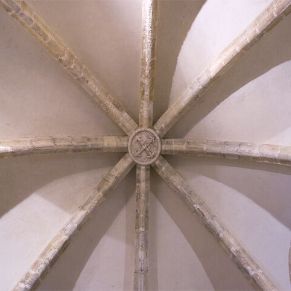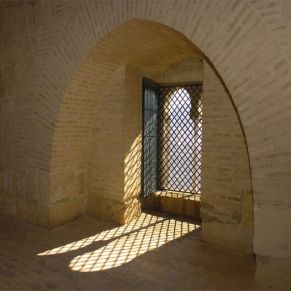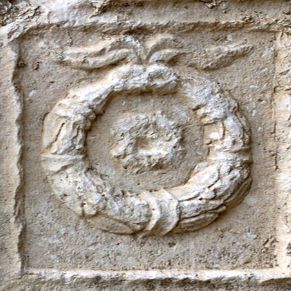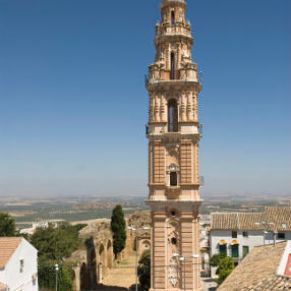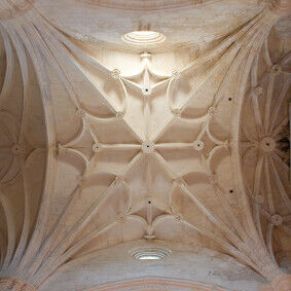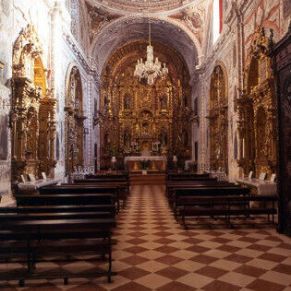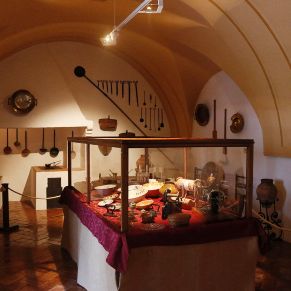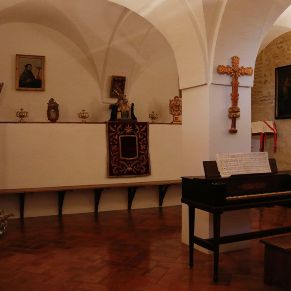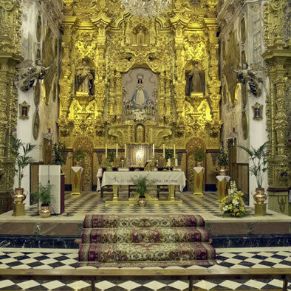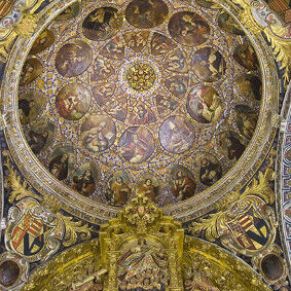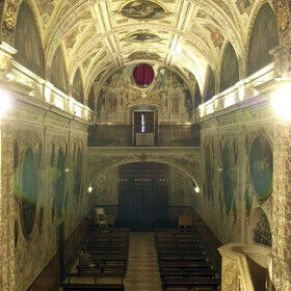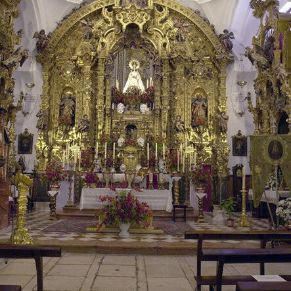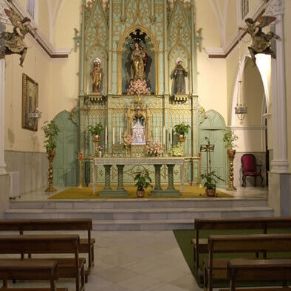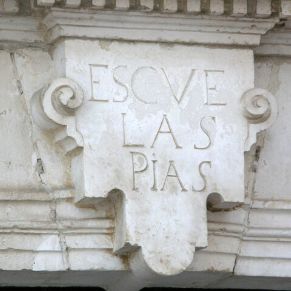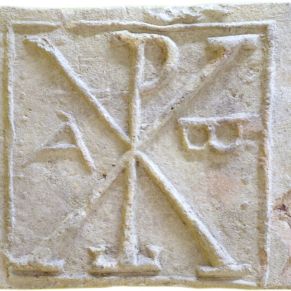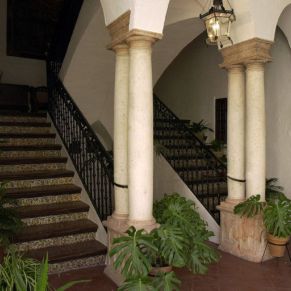Attraction Sites
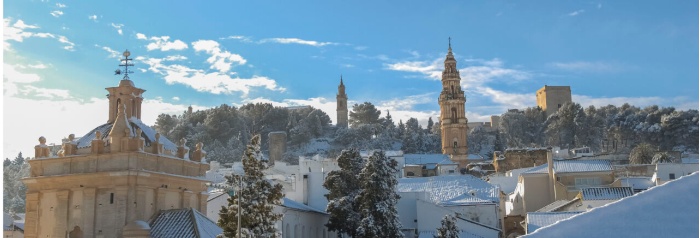
From the end of the 3rd century bc on, Estepa and the towns nearby experienced a process of adaptation to the Roman culture that took place in the peninsula. Our town is therefore mentioned in major Roman literature regarding the Punic Wars, as well as the Civil War, such as Bellum Hispaniense and those written by the celebrated Roman authors Titus Livius and Caius Plinius. One of the remarkable yet violent episodes in which Estepa was involved in at the time was the taking of Astapa, a pre-Roman settlement occupied by the Turdetani people in the area where Estepa nowadays lies. Lucius Marcius besieged the city, but its inhabitants preferred to commit suicide rather than to live in a state of oppression, just like the people from the ancient Celtiberian settlements of Numancia, Sagunto or Calahorra did.
Monuments and Churches Schedule
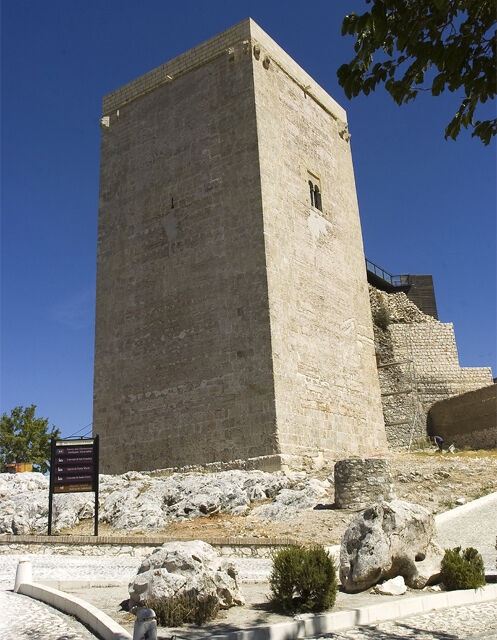
El Homenaje Tower is, without a doubt, the most interesting landmark in the tourist site of the Cerro de San Cristóbal hill. It is a rectangular tower built in 1390 using ashlar masonry alternating header and stretcher bonds at the base, in the corners and around the openings. The rest of the walls were built using rammed earth. It is 26 metres high, and each side is 13 metres wide. The lower part of the tower has no openings and, inside it, there is a square-based chamber covered with an octagonal rib Gothic vault. The ribs rest on the corbels are decorated with the traditional five fig tree leaves which resemble the ones in Lorenzo Suárez de Figueroa’s family’s coat of arms.
The Cross of Saint James (the symbol of the Order of Santiago) is sculpted at the centre of the vault, a very meaningful location that alludes to the influence that the religious and military Order of Santiago had over the old village of Estepa from 1267 until 1559. The wall facing North as well as the one facing South have openings with arched windows. At the top the only thing left from the original building are the traces from the corbels that used to serve as support for the lookout posts.
The construction work that was needed in order to build the tower implied a significant reorganisation of the Western part of the original area. It also meant that the process of feudalism that affected the local population and culture and took place during the Middle Ages had reached its peak. One can tell this from looking at the mix between military, social, anthropological, and symbolical elements and concepts that remain in the tower.
The historical records after the construction of the tower mention the following inscription in medieval Spanish that the tutor of the tower ordered to place above the entrance:
“ESTA TORRE MANDO FAZER DON LORENZO SVAREZ DE FIGVEROA MAESTRE DE SANTIAGO. QVIEN QVISIERE SABER LO QUE COSTÓ, FAGA OTRA COMO ELLA, Y SABER LO HA”
This means something along the following lines: SIR LORENZO SUAREZ DE FIGVEROA, GRAND MASTER FOM THE ORDER OF SANTIAGO, ORDERD TO BUILD THIS TOWER. WHOEVER WISHES TO KNOW THE WORK PUT INTO IT SHALL BUILD ANOTHER ONE
Address: Cerro de San Cristóbal
We offer guided tours. For further information please visit our Tourist Information Centre in Calle Aguilar y Cano Street. Tel: +34 66995227

La Victoria Tower is the only building left from what once was the Victoria Church, which was part of the Padres Mínimos Convent, devoted to the religious Order of the Minims. This religious order and its founder, Francis of Paola, arrived in Estepa in 1561. They were favoured by the marquises of Estepa. This 40-metre-tall tower was built from 1760 to 1766 and one can clearly distinguish five different parts in it. The façade, combined of bricks and stone in the ledges and base of the tower, is one of the most important baroque landmarks in Andalusia and is considered a national monument since 1955.
Address: Plaza de la Victoria

During Muslim Spain, more specifically in the 10th century, a mosque was built where the current de Santa María Church now stands. Then, the town was reconquered by the Christians in 1241. The old mosque was torn apart and a church, Mudejar in style, was built instead. We still preserve some remains of the arches and pilasters from this church. However, it was still not until the end of the 15th century and beginning of the 16th that the Santa María Church that we know nowadays was built. Late Gothic in style, the church is now home to major artworks, such as the main altarpiece by Andrés de Ocampo, the sculpture of San Juan Evangelista (John the Evangelist) crafted by Juan de Mesa and a 16th century baptismal font.
Address: Cerro de San Cristóbal
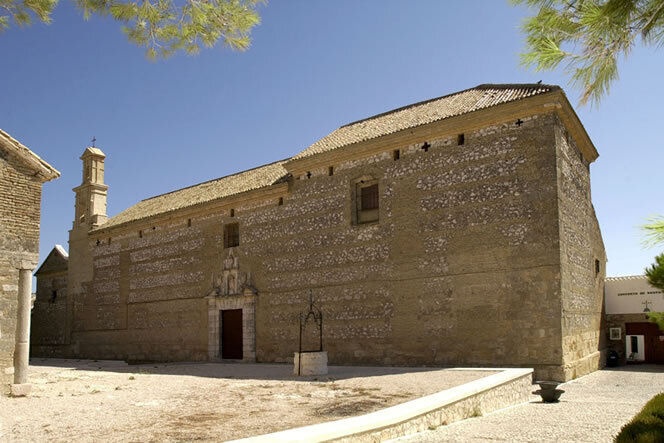
Santa Clara Church and Convent was founded in 1599 by the marquises of Estepa, although most of it was built in the 17th century. It follows the traditional pattern for this kind of convents in Spain: it consists of one nave covered by a barrel vault and a semi-circular chapel right before the chancel. Regarding the decoration, the main altarpiece is an artwork from 1708 from the artist Pedro Ruiz Paniagua. There is also a great variety of Christian iconography on the walls of the church.
Santa Clara Convent also has the oldest bakery in Estepa. They sell their delicious cakes and cookies through the revolving window located in the open courtyard.
Opening Times: 9am – 1pm, 4pm – 6pm
Schedule for mass at the Iglesia de Santa Clara church:
Winter Schedule: Sunday: 6pm. Summer Schedule: Sunday: 7pm. FREE ENTRANCE.
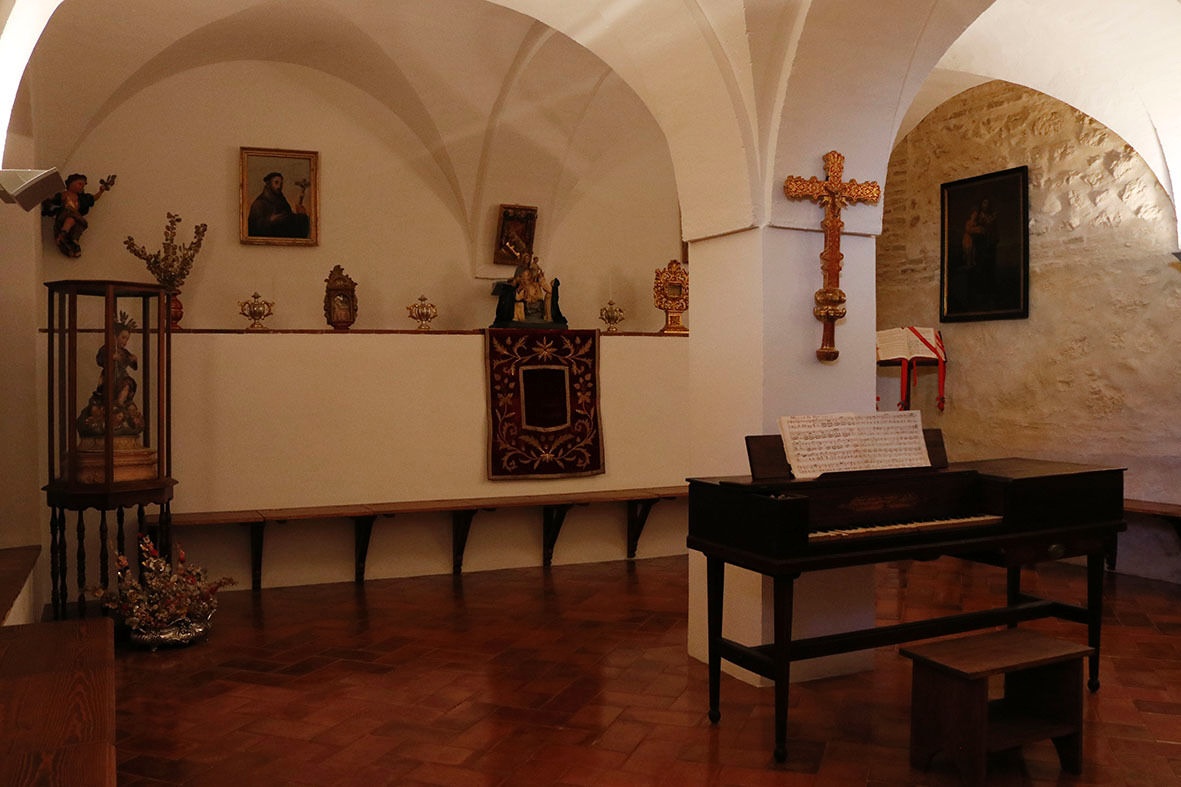
The Ancient Santa Clara Convent is a heritage site located in the north-eastern side of the Cerro de San Cristóbal hill. It was built in 1599, during the period in which the marquises of Estepa had great influence over the town. The cloistered nuns have recently carried out a project to turn the convent into a museum too. This ensures that both visitors and locals can learn about its interesting history. During the visit, you can stroll around the different rooms it has and find out what they were used for. They are decorated with ornaments and furniture similar to those from the end of the 16th century, in order to preserve its initial appearance and take its visitors to another era.
This ensures that its history and heritage is kept alive in a quiet environment where everyone is welcome. It is a unique experience to visit a traditional Andalusian convent in which Christian prayers and Arabic cisterns coexist. The visit begins in the charming courtyard and continues in the original kitchen. Next, you will get an insight of the nuns’ atelier, which used to be the nurses’ basement. The visit ends in the refectory, the dining room of the monastery, where everyone would either grab a bite or read their favourite books.
If you wish to learn more about the roots and culture of Estepa, do not let the opportunity to visit the convent slide!
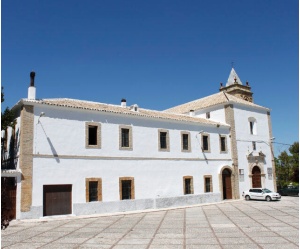
Founded by the religious Order of the Friars Minor, the church and convent were built from 1612 to 1646 right where the ancient San Cristóbal Chapel used to be. Inside, you will be able to admire the majestic altarpieces. These artworks were made in the art ateliers from Lucena and Antequera, two nearby towns. Another highlight is the wooden sculpture of San Francisco de Asís (Saint Francis of Assisi), carved by the academician and sculptor Luis Salvador Carmona around 1743.
Address: Cerro de San Cristóbal
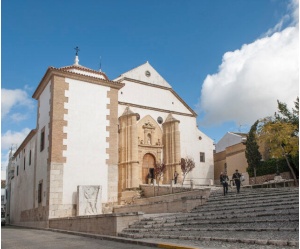
In the 16th century there was already a San Sebastian Chapel. However, it only had one nave and needed repairing. So, they started rebuilding it in 1568 under the instructions of the Genoese architect Vicente Boyol. Still, the church that we know nowadays was not finished until the 17th century. Regarding its structure it has three main naves and two side-aisles with chapels. Inside the church there are beautiful artworks crafted by the artist Luis Salvador Carmona. Some examples are the wooden sculptures of Nuestro Padre Jesús Nazareno (Jesus Christ) from 1759, San Juan Bautista (John the Baptist) from 1743 and San Francisco de Paula (Francis of Paola) from 1757.
Address: Plaza de San Sebastián

This church was built around 1636 and its origin is linked to an ancient chapel in poor condition (Cristo de la Sangre Chapel). It was located in the outskirts of Estepa and, instead of rebuilding that one, they decided to build a new church in the old town. This new church, rebuilt thanks to the donations of Juan Martín Formariz, has one of the most representative façades from the 18th century Andalusian Baroque style, assembled by Andrés de Zabala. Entering the church, you will find a small chapel built around 1714 that catches everyone’s attention. It guards the beautiful wooden sculpture of La Virgen del Carmen (Our Lady of Mount Carmel).
Address: Plaza del Carmen
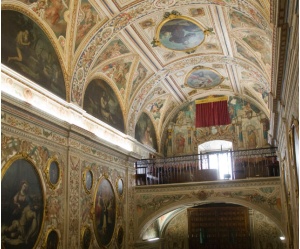
The origins of this charming church are also linked to an ancient chapel. It was built in 1616 and several testimonies from this time period support the idea that there was a chapel devoted to a Virgin with the same name (Asunción) in Mesones Street. Thirty years later, it was demolished, and this new church was built instead. The outcome was a beautiful church blessed in 1652. Regarding its structure, it has a main nave, a sacristy, and a chapel. However, it was not until a century later that it was decorated in Baroque style. It was then when the extraordinary paintings that cover the side walls, vaults and chapels were incorporated to create a unique visual experience.
Address: Calle Castillejos, 14
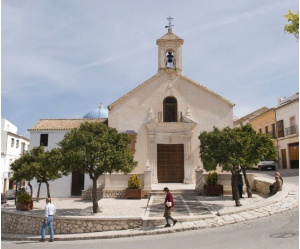
The origins of this church are once again liked to an ancient chapel (Vera Cruz Chapel) from the 15th and 16th centuries that was expanded in the 17th century. Regarding its structure and decoration, the chapel is an extremely interesting and valuable landmark from the 18th century. The altarpiece in the main altar is another artwork from the 18th century worth admiring, as well as the sculpture of La Virgen de los Remedios (Our Lady of Los Remedios) in the centre. This altarpiece also includes smaller sculptures representing Jesus Christ. These are El Cristo de la Vera Cruz (crucified) from the late 16th century, El Cristo de la Columna (tied to a column), crafted by Andrés de Carvajal during the second half of the 18th century and El Cristo de la Humildad (humble), crafted by Diego de Márquez also during the second half of the 18th century. The procession of El Dulce Nombre departs from this church and its wooden sculpture was crafted in the 17th century in an atelier in Granada.
Address: Plaza de los Remedios
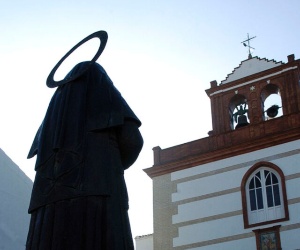
This convent was built in 1926 thanks to the donations of Sir Antonio Álvarez Sobrevilla and his wife Ms. Remedios. Both the façade and interior of the convent are Neogothic in style. Some of the sculptures displayed inside the convent are lamp-bearing angels that were originally in La Concepción Church and a wooden one crafted by Miguel Márquez that represents San Francisco (Francis of Assisi).
Address: Plaza de Santa Ángela
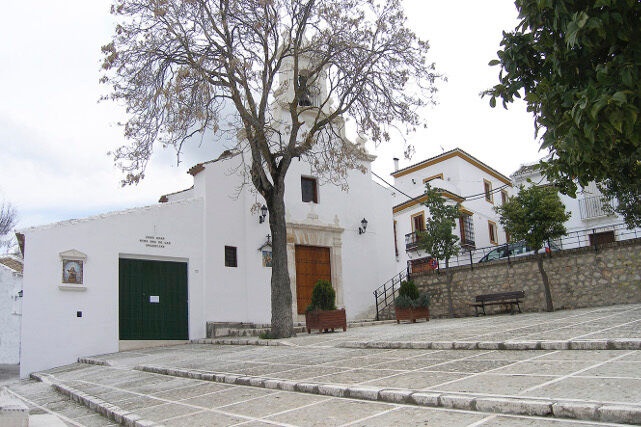
This church is home to the prayers and heartfelt devotion from the whole quarter of La Coracha. Although its origins are unclear, the testimonies and writings from that time period imply that it could have been built during the second half of the 18th century, while the façade was added in 1840. Regarding its structure, it has one main nave covered by a barrel vault with small openings. The main altarpiece has a sculpture of Santa Ana (Saint Anne) with her daughter, the Virgin Mary as a child. It was crafted in 1780 in an atelier in Antequera, a town nearby. This church is also home to the Virgen de las Angustias (Our Lady of Distress), a sculpture of the Virgin that was crafted by Diego Márquez and is carried along the streets of Estepa during Easter Week.
Address: Plaza de Santa Ana

Although this chapel was built in 1845, it had to undergo a complete repair and was reopened on the 15th of October 1994. It has a charming façade and a bell gable with two arches on top. Entering the chapel, you will find a small sculpture of San Marcos (Mark the Evangelist) inside the main niche.
Address: Esquina Calle Risco y Calle Roma
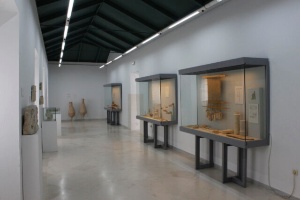
This building has been used for several purposes throughout its lifetime. It acted originally as the headquarters of an organisation related to the religious Order of the Piarists. In 1671 it was rebuilt and served as a prison for almost 300 years. It was not until 1993 that the building was rearranged into a museum. Although it is an archaeological museum, there is a room dedicated to Antonio Aguilar y Cano’s work, a distinguished local historiographer and writer from the 19th century.
Regarding the organisation of the museum, there is a traditional Andalusian patio (courtyard) at the centre. The temporary exhibitions take place on the ground floor and the collections are found around the staircase to access the building, as well as the upper gallery and three more rooms around it. These collections contain inscriptions, stone tools, ceramic, metallic, constructive and religious objects, and much more from Prehistoric, Protohistoric and Roman times. There are also fascinating bricks decorated with religious symbols from Early Christian and Visigoth times, as well as several kinds of ceramic findings from Muslim Spain. Eros Durmiente (Sleeping Eros), an artwork from the first half of the 2nd century, is considered the most fascinating piece.
Address: Calle Ancha, 14
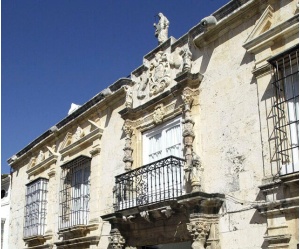
This palace was built in 1756 as a home for the Marquises of Cervales. It is one of the few examples of urban Baroque architecture in Andalusia that maintains its original features. At a national level, it was even declared a site of cultural and historical interest in 1984.
It is open Monday through Sunday. Please call the following phone number to book a visit in the Marqueses de Cerverales Palace: Tel.: 661 659 895
Ticket price: 6€.
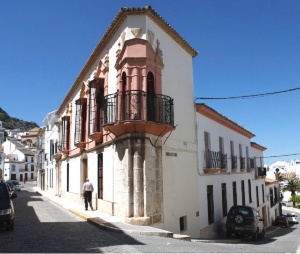
Only the main entrance and façade remain from what used to be a beautiful 18th century palace. However, you can still admire the elegant Baroque balcony of this magnificent ancient palace from both streets that meet right at this spot.
Address: Esquina Calle Amargura y Calle Virgen de la Esperanza
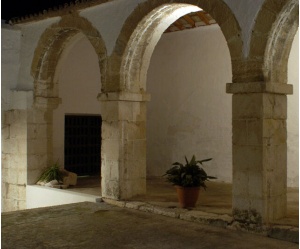
Built in 1770 and designed by the architect Andrés de Zabala, this landmark has been used for different purposes, such as to store grain, and as a factory to manufacture our famous mantecados (Christmas cakes and cookies).
Address: Plaza del Llanete
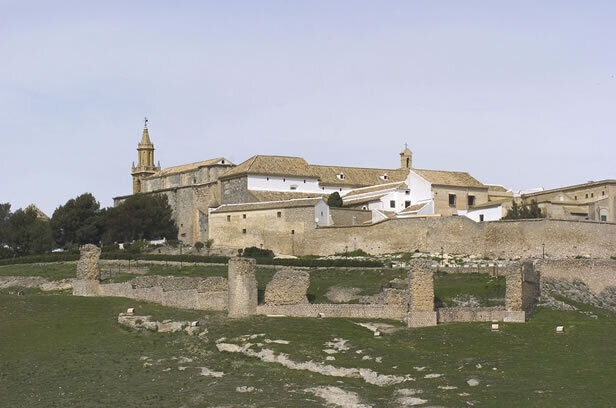
This wall was built in the 10th century, in Muslim Spain. However, it was reconditioned in the 12th century, during the Almohad Caliphate, and again during the rule of the religious Order of Santiago in Estepa (from the 13th until the 16th century). During the Christian Reconquest of the territory, this wall was one of the most important fortresses for the defence of the Islamic side.
Address: Cerro de San Cristóbal
This ancient Islamic fortress was also used as a palace. Its elevated location gave it a strategic position which the marquises of Estepa took advantage of to turn it into a fortified palace. From the original landmark, only the yard, some walls, and some cisterns remain. Some testimonies in Maese Miguel de Beyçama’s and Sancho de Garra’s plans of the palace from 1543 indicate that the main entrance to the fortress used to face North and was built in a strategic way using paths and curves to confuse its potential enemies. Right in front, there used to be an ancient town square and there were small towers on the perimeters of the fortress. The cisterns were surrounding it too.
Address: Cerro de San Cristóbal
This traditional Andalusian Cave House, also called La Cueva de la Carrita, is accessed through the Carril de Santa María Street, that takes you all the way from the Plaza Vieja Square to the Cerro de San Cristóbal hill. It is one of the few parts remaining of what once was the Cuevas de Orán quarter, made up of cave houses excavated on the sides of the hill. There were people living in them until 1963, when they were forced to leave because of the poor condition of their infrastructure. Some of them had even partially or fully collapsed, making it impossible to access them.
Address: Carril de Santa María (Cerro de San Cristóbal)
